How to graft a fruit tree with budding (bud, eye) in the summer: step-by-step instructions for beginners
So, you have decided to inoculate your fruit tree seedling with budding (or they also say "graft with an eye" or "bud"). Indeed, budding with an eye is one of the simplest ways of grafting, which even a novice amateur gardener can figure out.
Next, you will learn about when and how to vaccinate by budding in the summer, what is needed for this, what methods exist.
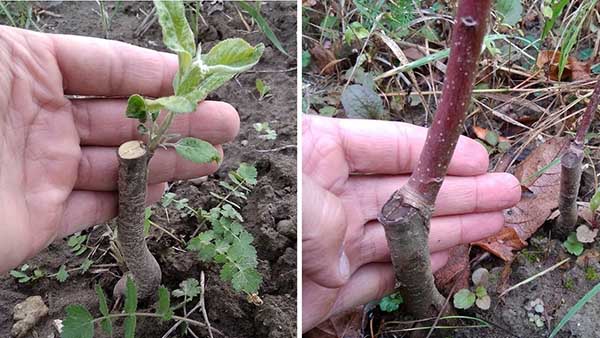
Content
When budding is carried out in the summer: in what time frame
Vaccination by budding is carried out in the second half of summer - from the 3rd decade of July to the 2nd decade of August (relevant for the Middle zone).
- Why in the summer, in August?
This is a period of active sap flow in the shoots, when the bark is easily separated from the wood, it is by this time that the buds ripen on the growths of this year (annual shoots).
Respectively, grafting by budding begins with stone fruit cultures - from the end of July, and already further - from August - they switch to seed (apple and pear), because in stone fruit crops (cherry, sweet cherry, plum) sap flow begins and ends earlier than in pome crops.
- Is it possible to inoculate with an eye before?
If budding is carried out too early (at the beginning of July), then the buds can germinate in the fall, which means, most likely, they will not survive the winter.
However! You can try to execute spring budding. You just have to wait the beginning of sap flow... At the same time, cuttings harvested in the fall of last year are used. The bud will bloom and sprout this spring.
And yet this method is almost never used, except for the budding of stone fruit crops (cherries, petioles, plums).
- Why not later?
The eyes may simply not have time to settle down to the stock.
For normal accretion after budding, an average of 30 days should pass with a temperature above + 16-18 degrees. Accordingly, in the warm southern regions, budding can be done in autumn (in September-October).
What is grafting by budding, goals and scope (which trees can be grafted)
The essence of budding (inoculation with an eye) is that it is grafted onto the stock not a whole stalk, but only the bud (eye) of the scion cut off from it (with a thin layer of wood, they also say "with a shield")... In other words, budding is the transfer of a bud from one tree (cultivated variety) to another (non-varietal, i.e. wild game).
As a result, in the spring of next year, the implanted bud starts to grow, a shoot grows from it, from which a tree is later formed.
Accordingly, this method is used to inoculate young seedlings — wild birds (1-3 years old);
In very rare cases, budding is used to inoculate young skeletal branches (1-3 years old) of mature trees.
The main advantages of vaccination by budding method include:
- high survival rate (literally 95%);
- small costs of grafting material.
That is why this method of grafting, as a rule, is used by farmers in nurseries when they propagate (grow) seedlings for sale.
All pome fruits (apple trees, pears, quince) and stone fruits (cherries, sweet cherries, plums, apricots, peaches) fruit trees can be grafted by budding.
Do not forget about compatibility: stone fruits are grafted only on stone fruits, and pome fruits - on pome fruits (related crops):
- A pear can be grafted onto an apple tree and vice versa, but it is optimal - an apple tree on an apple tree, a pear on a pear (i.e. single species).
- But you won't be able to plant a plum on an apple tree (and vice versa).
What is required for budding and how to prepare a scion
Tools
To carry out budding, you need the following tools:
- Oculus knife;
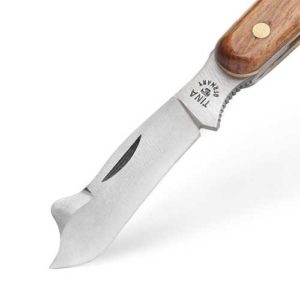
- Strapping film (plastic tape, in extreme cases - electrical tape, which must be removed by yourself);
Ideally, a special (photodegradable) film (sold under the name "Shanok") is used for inoculation and budding, which itself is destroyed under the influence of ultraviolet rays (that is, it will not even need to be removed afterwards).
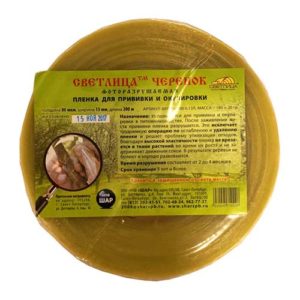
Rootstock and scion
The stock is the seedling you will be grafting onto. As a rule, 1-2 year old wild boar is used as a rootstock for budding (a tree grown from a seed or stone).
At the same time, in the conditions of the same Middle zone (Moscow region) and other cold regions for rootstock use the most winter hardy varieties.
A graft is a varietal cutting, and in this case, a shield with an eye (bud), which you will graft onto the stock.
Where to get the scion?
Ask your neighbors to either buy at a garden fair, or better at a nursery, or order online.
Scion preparation: cuttings and eyes (buds) with a shield
For grafting by budding, you must first prepare cuttings for the scion, namely:
Note! Cuttings-future scions it is desirable to procure on the day of vaccination.
However, it is allowed to store cuttings in a damp material (wrap with a damp cloth and put in a bag) in the refrigerator, but no more than a week.
- Cutting down annual stalk (= current year's shoot) about 40 cm long.
As a rule, cuttings are taken from the upper part of the crown from the south or west side.
- Gently pick (remove) all the leaves from it.
Some gardeners try to leave the stalk (petiole) of the leaf, however, this is more relevant for T-shaped budding, whereas most often budding is done with a knife butt (but if you want, then the petiole can be left, only in the future it should not be wrapped, and leave the peephole open).
- Next you need cut off 2-3 lower and upper buds (shorten the stalk from below and above), i.e. only the middle part of the shoot is used for grafting.
Now you must directly prepare the scion, namely, correctly cut off the bud (eye) with a shield:
- We take the handle in the left hand, put our finger under the kidney (eye).
- We make one short cut under and above the kidney, and then turn the knife over and start cutting from the bottom up, cutting off the kidney with a shield (a thin layer of wood).
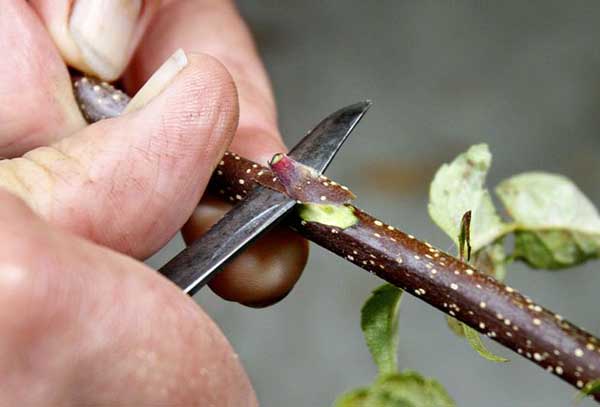
- After cutting, the top of the shield should be between your knife and thumb.
How to inoculate by budding: a step-by-step guide
The most popular is budding "butt", because done much faster and easier (as opposed to "T-shaped").
That is why the sequence of actions for this method of budding will be described below, and the "T-shaped" one is placed in a separate paragraph (so to speak, for those interested).
Ovaluation "applied"
Step-by-step instructions for summer vaccination by budding in stock:
Important! Before budding the knife must be disinfected (wipe with alcohol), and already in the process of work also periodically wipe with a clean cloth (special when budding stone fruitsince most of all sticks to the blade). And in no case should you put your knife on the ground!
- It is advisable to carry out budding itself in the morning, as well as cut the cuttings (at this time they are maximally saturated with moisture).
- Prepare the stock for budding: remove all the lower branches, then carefully wipe the trunk from dirt and dust (the place where you will plant).
- For budding, it is better to choose the north side of the rootstock in order to avoid direct sunlight at the grafting site (it was in shade).
If you choose the south side, then the peephole under the film may die from damping.
- Budding is carried out at a height of 5 to 10 cm above the ground (above the root collar).
The lower the grafting, the better the accretion, the closer the roots, and the more powerful the seedling will grow. In other words, the budding height will further affect the growth rate of trees.
By the way! On a dwarf rootstock, budding is recommended at a height of 15-18 cm.
- Now you need to make an incision on the rootstock at the site of the future grafting and slightly bend the wood (make a "pocket").
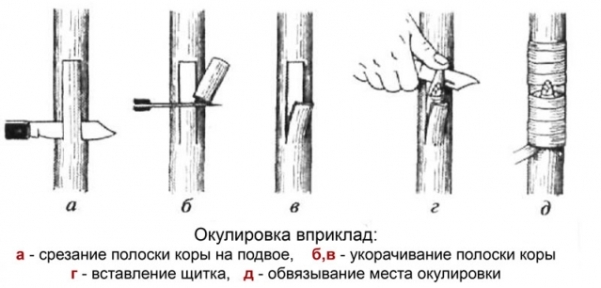
It is recommended to discard the cut out part of the bark, but before that it can be left, so to speak, "for trying on" (this is the shape we will need a graft).
- To prepare the scion - cut off the bud with a shield (see separate paragraph).
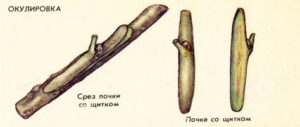
- Combine the scion with the stock. Namely, to drive under the bark (put in a pocket) the stock a shield with a bud (eye), and preferably without removing it from the knife.
Ideally, the shield should fully correspond to the incision on the rootstock (the edges should completely match), only in this case they can grow well together and the graft will take root.
- If the flap is slightly longer, then after you place it in the pocket on the rootstock, the top can be trimmed.
- If the scion is thinner than the rootstock, then it is better to apply a narrow shield to one of the edges of the cut on the rootstock in order to combine the cambial layers of wood.
- It remains to tightly wrap the grafting site with tape (from bottom to top) and secure it by making a knot on top.
Typically a peephole (kidney) wrap up completely (including for so that the kidney does not wake up ahead of time), however, some leave the eye (kidney) is open.
In general, it is on stone fruits (cherries, cherries, plums) that it is recommended to leave the peephole (bud) open.
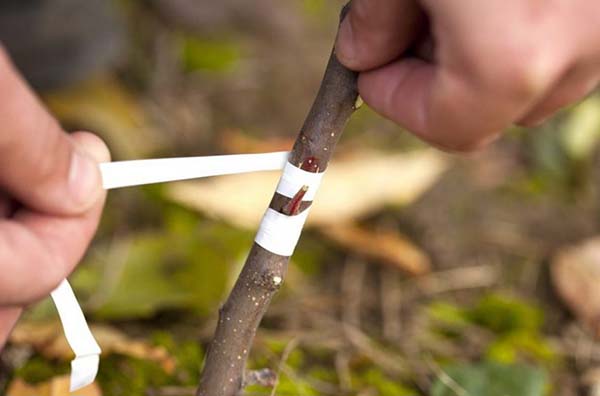
- About 3-4 weeks (month) after budding, when the kidney takes root, the tape can be removed (Carefully cut the tape on the back of the grafting with a sharp knife, and it will gradually fall off by itself) or slowly unwind.
However! So that mice do not eat your varietal bud under the snow, it is better to leave the wrapper until spring and remove it immediately after the snow melts (especially important for apple and pear).
- And in the spring you will need trim the seedling right above your grafted bud (about 1-2 cm above the eye).
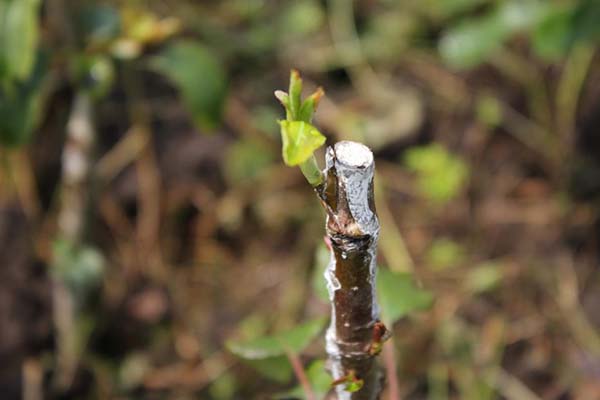
- Next, you need to monitor the growth of the shoot from the bud and tie up in timeso that the trunk (stem) is not crooked (and the wind does not break off a weak shoot).
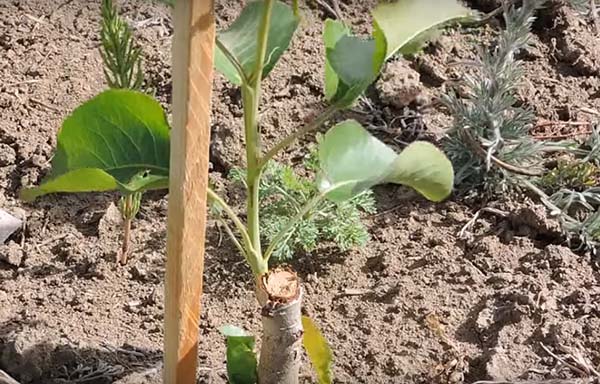
In "T-shaped cut"
T-shaped budding is used much less often, the difference of which is that a T-shaped incision is made on the rootstock at the grafting site, which is much more difficult (but reliable, of course, if everything is done correctly).
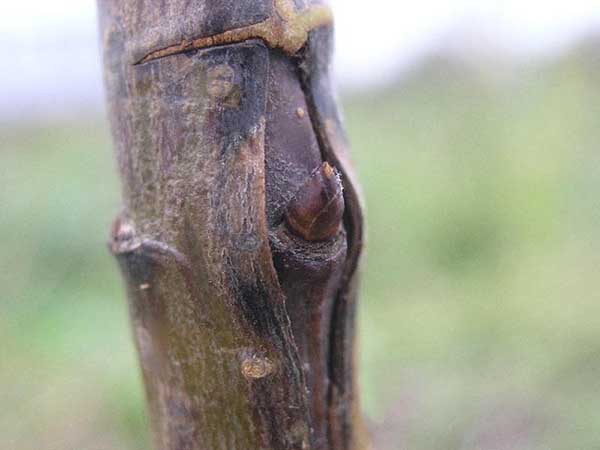
The sequence of performing T-shaped budding is shown in the diagram:
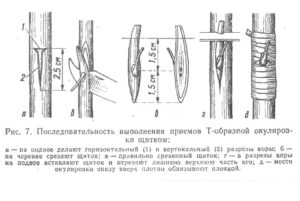
Answers to popular questions about summer budding
Several answers to popular questions about budding vaccination.
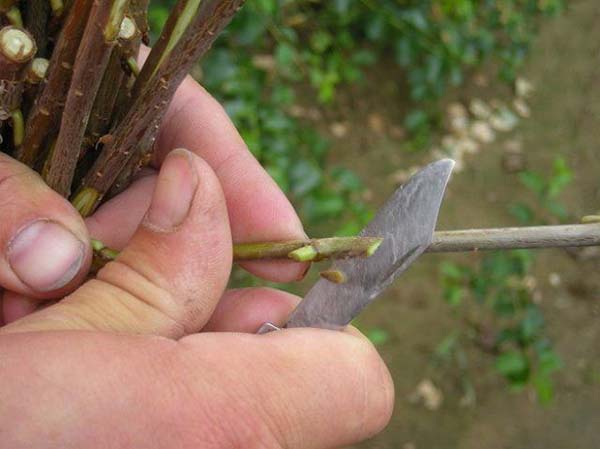
When exactly should budding be carried out in late July or August?
First, they start budding stone fruit (they start sap flow in the shoots earlier), then pome crops. The main thing is that on the rootstock bark peeled off easilyand this is happening during the period of active sap flow (late July-early August).
Accordingly, in the southern regions, budding can be done later, i.e. autumn (September-October).
When does a kidney awaken by budding during summer vaccination?
What if the kidney woke up and started to grow in the fall?
When to remove the tape after vaccination?
When everything grows together, as a rule, 3-4 weeks (maximum - 30-40 days) after budding.
Wherein on apple and pear (pome crops) can be left until spring (6-7 months)so that rodents (mice, hares) do not gnaw the vaccination site in winter. And here stone fruits (cherries, cherries, plums) take off the tape better autumn (one month after vaccination).
Of course, also by no means the formation of constrictions on the stock must not be allowed.
By the way! If you used just electrical tape, then it must be removed in the fall.
When will the grafted seedling begin to bear fruit?
The timing of the tree's entry into fruiting depends not only on the rootstock, but also on the variety itself, its early maturity.
For example, as for the apple tree, on a strong seed stock, fruiting occurs in the 5-8th year (and even earlier on the clone), while on early-growing varieties - already in the 5-6th year, and on non-early-growing ones - only for the 7-8th year.
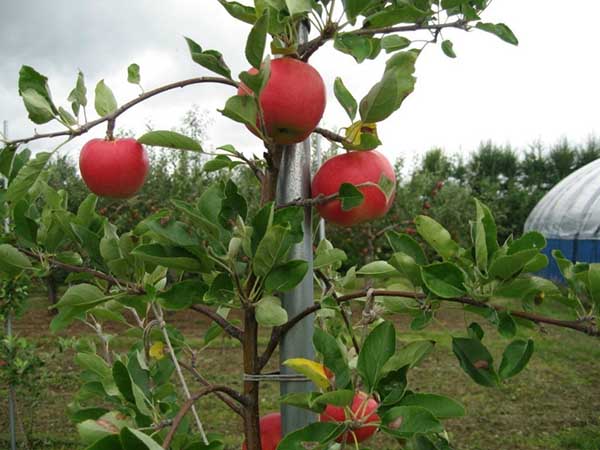
Despite the fact that budding is one of the simplest methods of vaccination, a novice “garden surgeon” may not be able to do everything right away. In any case, you first need to practice, so to speak, get your hands on (gain experience). Good luck!
Video: budding for a beginner - simple and affordable about summer tree grafting

